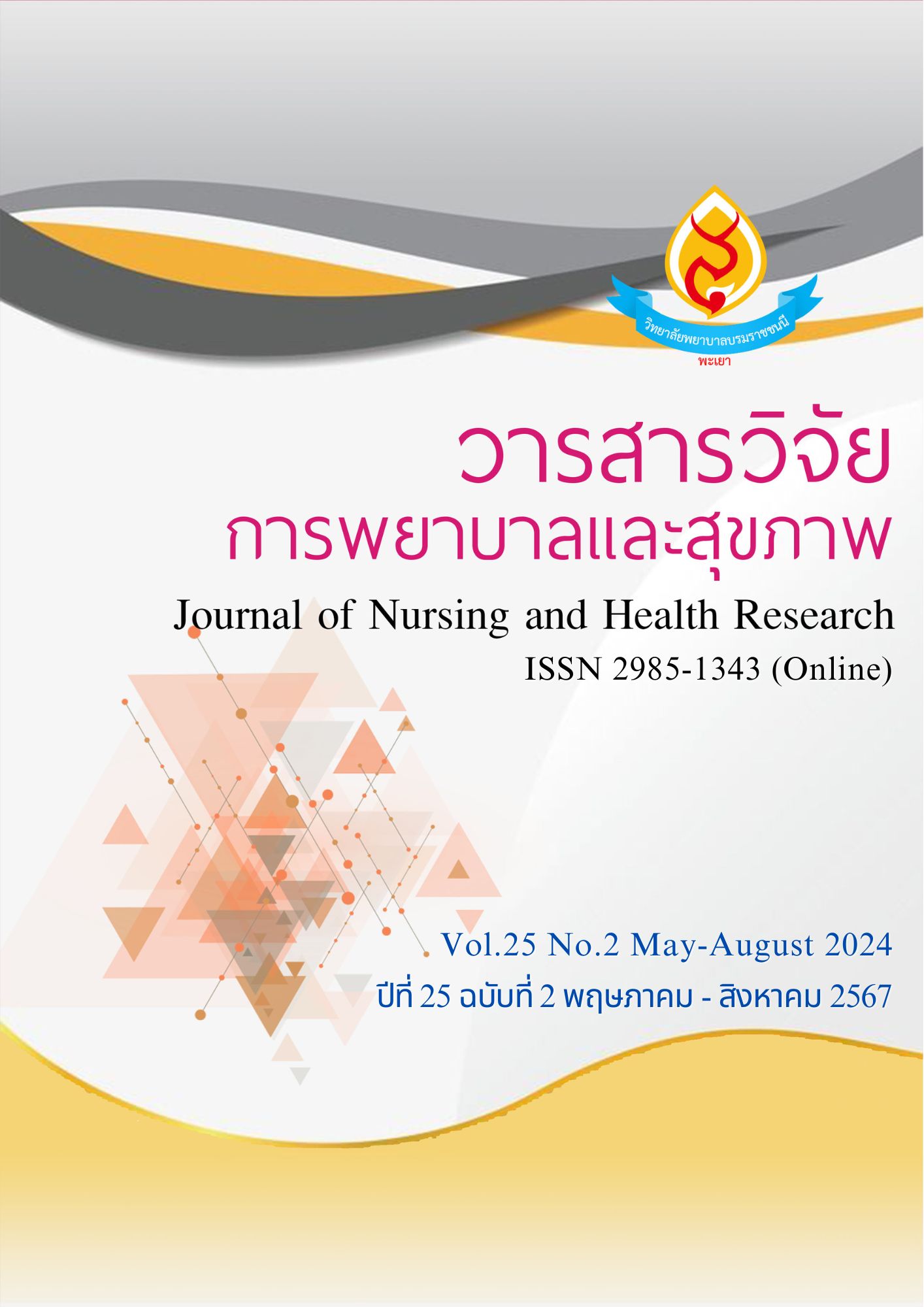ปัจจัยที่มีอิทธิพลต่อการเลี้ยงลูกด้วยนมเเม่ของมารดาหลังคลอดในหอผู้ป่วยหลังคลอด
คำสำคัญ:
การเลี้ยงลูกด้วยนมแม่, มารดาหลังคลอด, แรงสนับสนุนทางสังคมบทคัดย่อ
การเลี้ยงลูกด้วยนมเเม่มีความสำคัญต่อภาวะสุขภาพของลูก การศึกษาเกี่ยวกับปัจจัยที่มีอิทธิพลจึงเป็นสิ่งจำเป็น การวิจัยเชิงปริมาณแบบภาคตัดขวางนี้ มีวัตถุประสงค์เพื่อศึกษา การเลี้ยงลูกด้วยนมแม่และปัจจัยที่มีอิทธิพลต่อการเลี้ยงลูกด้วยนมแม่ของมารดาหลังคลอดในหอผู้ป่วยหลังคลอด โรงพยาบาลสวรรค์ประชารักษ์ จังหวัดนครสวรรค์ กลุ่มตัวอย่าง คือ มารดาหลังคลอด อายุ 18 ปีขึ้นไป จำนวน 180 คน เก็บข้อมูลโดยใช้แบบสอบถาม ความรู้ เจตคติ แรงสนับสนุนทางสังคมเกี่ยวกับการเลี้ยงลูกด้วยนมแม่ และแบบประเมินการให้นมลูก มีค่าความเชื่อมั่น เท่ากับ .75 .77 .88 และ .70 ตามลำดับ วิเคราะห์ข้อมูลโดยใช้สถิติเชิงพรรณนา และการวิเคราะห์การถดถอยโลจิสติกแบบทวิ กำหนดระดับนัยสำคัญทางสถิติที่ .05 ผลการวิจัย พบว่า การเลี้ยงลูกด้วยนมแม่ของมารดาหลังคลอด ในหอผู้ป่วยหลังคลอด มีค่าการประเมินการให้นมลูกผ่านเกณฑ์มาตรฐาน ร้อยละ 47.20 ปัจจัยที่มีอิทธิพลต่อการเลี้ยงลูกด้วยนมแม่ของมารดาหลังคลอดในหอผู้ป่วยหลังคลอด ได้แก่ เเรงสนับสนุนทางสังคมระดับสูงมีอิทธิพลต่อการเลี้ยงลูกด้วยนมแม่ของมารดาหลังคลอดในหอผู้ป่วยหลังคลอด เมื่อเปรียบเทียบกับเเรงสนับสนุนทางสังคมระดับต่ำถึง 3.10 เท่า (95% CI 1.29-7.48) วิธีคลอดธรรมชาติมีอิทธิพลต่อการเลี้ยงลูกด้วยนมแม่ของมารดาหลังคลอดในหอผู้ป่วยหลังคลอด เมื่อเปรียบเทียบกับวิธีผ่าตัดคลอดสูงถึง 1.88 เท่า (95% CI 1.02-3.44) ดังนั้น การส่งเสริมการเลี้ยงลูกด้วยนมแม่ขณะพักในหอผู้ป่วยได้ ควรส่งเสริมการคลอดบุตรด้วยวิธีธรรมชาติ ประกอบกับการสนับสนุนและช่วยเหลือจากบุคลากรด้านสุขภาพและครอบครัว
เอกสารอ้างอิง
Bjørset, V. K., Helle, C., Hillesund, E. R., & Øverby, N. C. (2018). Socio-economic status and maternal BMI are associated with duration of breast-feeding of Norwegian infants. Public Health Nutrition, 21(8), 1465–1473. https://doi.org/10.1017/s1368980017003925
Chayanoak, L. (2015). Factors influencing breastfeeding behavior among adolescent mothers postpartum at Maharaj Nakorn Ratchasima Hospital [Research report]. Suranaree University of Technology. (in Thai)
Chupraphan, P., Tiangtham, V., & Pitchayapinyot, P. (2014). Factors influencing exclusive breastfeeding within a 6 months' period among mothers in South Central Region of Thailand [Master of Science Program in Public Health]. Mahidol University. (in Thai)
Chusilp. K. (2012). Assessment of breastfed infants. In Muttamara, S., Chusilp, K., Sutthaswawut, U., Sangtaweesin, W., & Haengchaowarit Y. (Eds.). Textbook of breastfeeding. Ayara Publishing.
Damjuti, I. & Kala, S. (2022). Factors influencing the success of exclusive breastfeeding for 6 months among working mothers. Journal of Nursing and Public Health Network of Southern Thailand, 9(1), 107-120.
Das, N. K., Duwadi, N., Sinha, R., & Dahal, A. (2024). Factors associated with exclusive breastfeeding among mothers of children under two years of age in Dalit community, Rajbiraj Municipality, Saptari, Nepal. medRxiv (Cold Spring Harbor Laboratory). https://doi.org/10.1101/2023.08.09.23292718
Dillman, D. A. (2000). Maitland internet surveys: The tailored design (2nd ed.). John Wiley & Sons.
Goon D. T., Ajayi A. L. & Adeniyi O. V. (2021). Sociodemographic and lifestyle correlates of exclusive breastfeeding practices among mothers on antiretroviral therapy in the Eastern Cape, South Africa. Journal of International Breastfeeding, 16, 1-9.
Griffin C. M. C, Amorim M. H. C, Almeida F. A, Marcacine K. O., Goldman R. E., & Coca K.P. (2022). LATCH as a systematic tool for assessment of the breastfeeding technique in maternity. Acta Paul Enferm, 35, eAPE03181. http://dx.doi.org/10.37689/acta-ape/2022AO03181.
House, J. S. (1981). Work stress and social support. California: Addison-Wesley.
Lande, M. S., Nedberg, I. H., & Anda, E. E. (2020). Factors associated with exclusive breastfeeding at hospital discharge: a study using data from the Georgian Birth Registry. International Breastfeeding Journal, 15, 1-10. https://doi.org/10.1186/s13006-020-00286-9
Li, L., Wan, W., & Zhu, C. (2021). Breastfeeding after a cesarean section: A literature review. Midwifery, 103, https://doi.org/10.1016/j.midw.2021.103117.
Ministry of Public Health. (2022, 5). Support exclusive breastfeeding for 6 months after a decrease in breastfeeding rates among infants. https://pr.moph.go.th/print.php?url=pr/print/2/02/177183/
Mundagowa P. T., Chadambuka E. M., Chimberengwa P. T., & Mukora-Mutseyekwa F. (2019). Determinants of exclusive breastfeeding among mothers of infants aged 6 to 12 months in Gwanda District, Zimbabwe. Journal of International Breastfeeding, 14, 1-8.
Motee & Jeewon C. R. (2014). Importance of exclusive breastfeeding. Journal of Nutrition Food Science, 2(2), 56-72.
Postpartum Ward, Sawanpracharak Hospital. (2021). Annual performance report 2021. Sawanpracharak Hospital.
Puapornpong, P. (2014). Breastfeeding assessment. Journal of Medicine and Health Sciences, 21(1), 4-15.
Reynolds, R., Kingsland, M., Daly, J., Licata, M., Tully, B., Doherty, Farragher, E., Desmet, C., Lecathelinais, C., McKie, J., Williams, M., Wiggers, J., & Hollis, J. (2023). Breastfeeding practices and associations with pregnancy, maternal and infant characteristics in Australia: a cross-sectional study. International Breastfeeding Journal, 18(1), 8.
Sanboonsong, P. (2016). Quality breastfeeding: Factors influencing breastfeeding and the role of midwives. Pathumthani University Academic Journal, 8(2), 244-256.
Shah M. H., Roshan R., Parikh T., Sathe S., Vaidya U., & Pandit A. (2021). LATCH score at discharge: A predictor of weight gain and exclusive breastfeeding at 6 weeks in term healthy babies. Journal of Pediatric Gastroenterol Nutrition, 72(2), e48-e52.
Thai Health Promotion Foundation. (2022,). Thai children have the lowest breastfeeding rates in ASEAN. ThaiHealth Official. https://www.thaihealth.or.th/?p=235995
Thaithae S, Yimyam S, & Polprasarn P. (2023). Prevalence and predictive factors for exclusive breastfeeding at six months among Thai adolescent mothers. Children, 10(4), 682. https://doi.org/10.3390/children10040682
Wangsawasdi, T., Kaleang, N., Phibun, A., Jaisomkom, R., & Hayese, W. (2014). Factors influencing the intention to exclusively breastfeed for 6 months among mothers in Narathiwat Province. Nursing Journal, 41(5), 123-133.
Wijitsukon, K., Saengphuem, P., Watayu, N., Ruangjirathian, S., & Payakkareung, S. (Eds.). (2016). Breastfeeding (5th ed.). Pre-One Co., Ltd.
World Health Organization. (2022). Increasing commitment to breastfeeding through funding and improved policies and program. https://apps.who.int/iris/bitstream/handle/10665/326049/WHO-NMH- NHD19.22-eng.pdf?sequence=1&isAllowed=y
ดาวน์โหลด
เผยแพร่แล้ว
รูปแบบการอ้างอิง
ฉบับ
ประเภทบทความ
สัญญาอนุญาต
ลิขสิทธิ์ (c) 2024 วารสารวิจัยการพยาบาลและสุขภาพ

อนุญาตภายใต้เงื่อนไข Creative Commons Attribution-NonCommercial-NoDerivatives 4.0 International License.



